
WORLD WAR ONE

above: Charging dug-in machine guns with your horse cavalry is never a good plan.
below: Typical trench warfare scene.
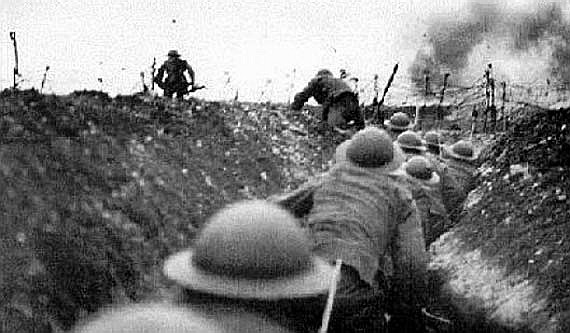
This is a part of our History page.
This page is one small part of Good Sites for Kids!
105 years ago this year (2019), the strong, healthy, progressive
institutions of European civilization came tumbling down, because of the
absurd decisions of foolish leaders and the violent actions of some madmen.
Four empires ceased to exist and two others went into their death spirals.
A lot of borders were redrawn. Without World War I, there would have been no Hitler, no Nazis, no Soviet Union, no Lenin, no Stalin, and no Communism. There would have been no World War II, no Cold War; and no Iraq, no Syria, no Jordan, no Lebanon, no Saudi Arabia. With no World War I, the Germans would have kept all their colonies. All those Pacific islands that were taken from Germany by Japan? They would have stayed German and probably been left unfortified.
Millions of people, especially millions of young men, would not have been killed. Who knows what great things they might have done?
The world has never been the same. Most of the 20th century was spent trying to put things back in some sort of order.
Links to learn more:
37 Days: Countdown to World War One from the BBC
firstworldwar.com A multimedia history of World War I
BBC - GCSE Bitesize - World War One and Two
June 28, 1914:
“One day the great European War will come out
of some damned foolish thing in the Balkans.”
- Otto von Bismarck
Simplified version: In 1914, Bosnia was a new province of Austria (It used to belong to the Turks of the Ottoman Empire). Serbia next door was an independent country. Many Serbs wanted to annex Bosnia to make it a new ethnic Slav country. There were Serbs living in Bosnia, too. They also wanted independence. One group of these decided that assassinating Archduke Ferdinand, the heir to the throne of Austria, would help their cause. The Archduke was visiting Sarajevo, capital of Bosnia. He wanted to improve life for the Bosnian people by modernizing the country and giving the people some political power. The assassins went to Sarajevo from Serbia. One of the men in the group shot and killed the Archduke and his wife. The assassin's name was Gavrilo Princip. He is still a national hero in Serbia, but in Bosnia (and the rest of the world) he is considered a terrorist. Like a snowball rolling downhill, his act started an avalanche of war.
The countdown to WW I began...
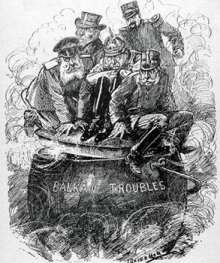
Thursday, July 23rd, 1914: The Austrians give the Serbs a
list of
insulting demands calculated to force the Serbs into war.
The Serbs have 48 hours to give an answer.
Saturday, July 25th, 1914: The Serbs reply to the Austrian
ultimatum
message by giving in on all but two demands. These were the two
nastiest ones that the Austrians were hoping the Serbs would reject.
The Austrians got their wish. The Austrians counted on the Russians
staying out of it. The Germans told the Austrians that Germany would
back them up if there was any trouble. The Germans also reckoned
the Russians would stay out. But they were wrong.
Sunday, July 26th, 1914: Austria-Hungary gets its armies ready
for war. Russia tells Austria-Hungary to leave Serbia alone or face
war with Russia. Britain wants a big peace conference, Germany
says no.
Tuesday, July 28th, 1914: Austria-Hungary declares war on
Serbia.
It will be at least two weeks before the old, decaying Empire can
get organized to actually attack. The Serbs use the time to dig in
and prepare nasty surprises.
Why didn't any of these countries
break the chain of events by
refusing to participate?
Our best guess is pride and a strong sense of "honour".
Deep down,
these old men leaders thought of war as cavalry charges and smashing
the enemy with ranks of infantry firing volleys from muskets.
The problem was, those days of "glory" were gone forever.
By 1914, every country had modern artillery instead of old fashioned
cannons. They had machine guns that would stop any charge. They
had aircraft. They had battleships and submarines. They had land mines
and barbed wire. They had explosives that were much more powerful
than gunpowder. They had very accurate bolt action rifles with clips of
ammo. The days of standing up in tight ranks and trading volleys of
musket balls were over. When the old fashioned generals tried fighting
the old fashioned way, they got millions of their young men killed for
no gains. You cannot march into machine gun fire, no matter how hard
you try.
Below: "Them days is gone forever."
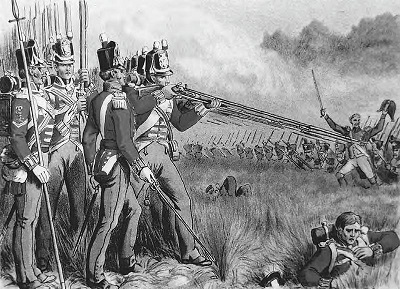
Why is this cartoon so accurate?
Bosnia, Serbia, and the other countries of the Balkans had been ruled by Turkey for hundreds of years. In the late 1800s, Austria, Britain, Russia, and other countries helped the Serbs and the rest push the Turks out. Immediately, the newly freed peoples attacked each other. The big powers of Europe moved in and took over to settle things down. In the end, Austria got Bosnia, in 1908. The Serbs, Bulgarians, etc, became free countries. Other areas were taken over by Italy, Russia, Romania, and others. A few years after this, Austria made Bosnia a part of Austria. Serbia and the Serbs who lived in Bosnia were not happy with this. Other groups of people* who lived in Bosnia were very happy to be protected from the Serbs next door!
(* Lots of Muslims lived in Bosnia. Lots of Croats from Croatia lived in Bosnia. Croats are Catholics and use a Western-type alphabet. Serbs are Orthodox, like Russians. Serbs use a Cyrillic alphabet, like the Russians. Serbs and Croats are close kin who speak the same language. So naturally they hated each other.)
In 1914, Bosnia was a new province of Austria. Serbia next door was an independent country. Many Serbs wanted to annex Bosnia to build a new ethnic Slav country. Some Bosnian Serbs thought that was a good idea. One group of teenagers decided that assassinating Archduke Ferdinand, the heir to the throne of Austria, would help their cause. They were supported and trained by the Serbian government, which gave them pistols and grenades. The Archduke was visiting Sarajevo, capital of Bosnia. He wanted to improve life for the Bosnian people by modernizing the country and giving the people some political power. The assassins went to Sarajevo from Serbia. One of the teens in the group shot and killed the Archduke and his wife. The assassin's name was Gavrilo Princip, age 19, who was a Serb from Bosnia. He is still a national hero in Serbia. Like a snowball rolling downhill, his act started an avalanche of war.
That's the end of the back story!
The First World War was sparked in the Balkans in 1914 when Serbian terrorists assassinated Archduke Franz Ferdinand of Austria in Bosnia's capital, Sarajevo. The Archduke was the heir to the throne of Austria-Hungary. He had been a force for peace, keeping Austria from attacking Serbia and trying to keep peace with Russia, too. There were riots against Serbs in Sarajevo. Across the border in Belgrade, the Serbian capital, there were celebrations.
The government of Germany gave the Austrians a "blank check", saying Germany would back them whatever they (Austria) decided to do. Austria-Hungary decided to conquer Serbia. The Austrians decided (after a few weeks) to send Serbia an ultimatum (a list of demands). The Austrian ambassador told the Serbian government that if the Austrian demands were refused, Austria would declare war and attack Serbia. This ultimatum was deliberately written to insult Serbia . It made extreme demands, calculated make the Serbs reject the ultimatum. Either the Serbs would let Austria take them over, or the Austrians would attack.
Serbia decided to fight. They asked Russia for help, as brother Slavs * and fellow Orthodox Christians. Russia was ready to go to war with Austria to help Serbia, if it came to that. Germany warned Russia to stay out of it. Germany also warned France not to help Russia. (France and Russia had a treaty, an agreement to help each other out if Germany started something.) France wanted revenge for the the German - French war of 1870, which France lost. (The official name of the 1870 war is the Franco-Prussian War.) The Germans thought they could whip France again. The French had put a chain of forts across the area where the Germans invaded in 1870. The Germans decided they would go into France by pushing through Belgium, a neutral country. They had a plan for this: the Schlieffen Plan.
.gif) **
**
* The Slavic peoples live mostly in Central, Eastern,
and Southeast Europe.
East Slavs are the Russians, White Russians
(Belarus = "white Russian"), Ukranians, Ruthenians, etc.
Central European Slavs are the Poles, Little
Poles,
Kashubians, and Mazovians, (the Polish peoples);
Czechs, Moravians, Slovaks, Sorbs, and Wends.
South Slavs are the Bulgarians, Serbs, Croats,
Bosnians,
Montenegrins, Slovenians, Macedonians, etc.
Just one big happy family!
**The northern half of Belgium is called
Flanders.
The people are called Flemings. They are ethnic Dutch,
but Catholics. They did not want to be part of the
Netherlands, which is Protestant (mainly Calvinist).
They speak a language that is almost Dutch.
The southern half of Belgium is called Wallonia.
The people are called Walloons. They are Catholics.
They speak French, but do not want to be part of France.
Flemings and Walloons don't get along.
But when the Kaiser tried to stop Austria-Hungary from declaring
war on Serbia, his own Foreign Minister overruled him, and kept
pushing for war. This was in spite of the Russian promise to attack
Austria-Hungary if they attacked Serbia. Later, as both Russia and
Germany mobilized (got ready for war), the Tsar tried 11 times
to
persuade the Kaiser (his cousin) to call it off. Russia was willing
to step back if Germany would. It still was not too late.
The problem was that the Kaiser had little power over his own
government, which wanted to help Austria-Hungary when, not if,
they attacked Serbia.
1 August - Germany declares war on Russia.
2 August - Germans demand that Belgium let
Germany's armies pass through Belgium on
their was to attack France, because
The Schlieffen
Plan
The Belgians said No.
This cartoon from Punch shows little Belgium
standing up to bully Germany. Germany has
a string of sausages hanging out so readers
of 1914 could tell this was Germany.

"Bravo, Belgium!"
3 August - Germany declares war on France.
4 August - Germany invades Belgium, and then
declares war on Belgium, too.
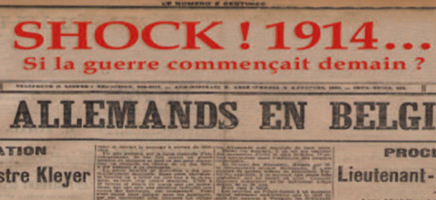
(Belgian newspaper)
At 2300 (11 PM), the UK declares
war on Germany.
Kaiser Wilhelm was NOT pleased. The Germans felt that
their invasion of Belgium was no big deal. They reckoned
that since they had violated Belgium's neutrality,
the Neutrality Treaty was now void. (lol,
wut?) If the
silly Belgians resisted, what happened next was their fault.
The UK disagreed with idea. Violently,
as it happened.
The next morning, 5 August 1914, this was the headline
on page one of the London Times:
"The lamps are going out all over
Europe,
we shall not see them lit again in our life-time."
British Foreign Secretary Sir Edward Grey
5 August - Austria-Hungary declares war on Russia.
6 August - Austrians try but fail to invade Serbia.
Germans marching through Belgium, but are slowed up
by Belgian forts.
7 August - Germans are in the city of Liege, Belgium.
Two Russian armies invade East Prussia on Germany's
eastern edge. Germans shocked, they thought they had
six weeks before the Russians got their act together.
Oops, they were wrong again.
Belgium needs every man! King Albert
goes into
the trenches. Taking a dead man's rifle, he fights
alongside his infantry.
This might not have been necessary if the Belgians
had copied the Dutch (see below).

Another look at the Schlieffen Plan
The Dutch were also on the German list for
invasion.
Their response was to enlarge, modernize, and upgrade
their army and navy. They built big new forts at the
border crossings, wired the major bridges with explosives,
and had Army units on standby ready to blow up the bridges
and dams to flood their country. The Dutch made sure that
the Germans knew all this. (The Netherlands is full of big,
tidal rivers and dams to keep out the ocean.)
Meanwhile, the Swiss mobilized their army, called up the
reserves, manned their forts, and wired the mountain passes
with explosives.
The Germans left those two countries alone (this time).
The Netherlands and Switzerland had ways of using their
land's geography to deal with invaders.
Since the 1870 war, the French had built a string of forts
along the border where the Germans had invaded before.
The only way left to get into France easily was through Belgium.
The Belgians were not ready, and did
not want to make the
Germans angry by doing what their Dutch neighbors had done.
So when the Germans said they were coming through, the
Belgians were in a bad place. They chose to fight, but it was like
The Alamo with similar results.
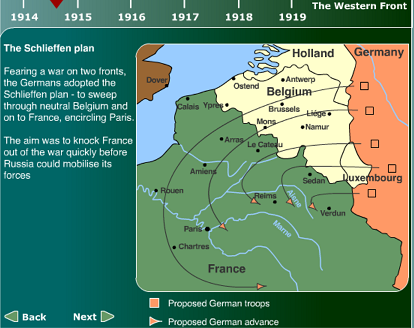 Animated
Map: The Western Front, 1914 - 1918 This BBC Flash slide show briefly
explains everything major that happened on the Western Front, 1914-1918,
including the offensives.
Animated
Map: The Western Front, 1914 - 1918 This BBC Flash slide show briefly
explains everything major that happened on the Western Front, 1914-1918,
including the offensives.
12 August 1914 - UK declares war on Austria-Hungary.
Serbs and allies attack Bosnia, get chased back out.
Germans slowly pushing through Belgium. Schlieffen Plan is going much too
slowly. Chances for success are going down.
14 August 1914 - French Army moves into Belgium and starts blocking the Germans.
15 August 1914 - Biggest Belgian fortress complex falls to
Germans (Liege). Germans then move on southwest, but run into the French
at Namur.
Meanwhile, the Russians smash an Austrian army near what is now the Poland-Ukraine
border. British Army begins landing on the Belgian coast.
Meanwhile, in China...
Remember, Japan was on the Allied side in WW I. The Japanese tell the Germans to get out of the German-owned port of Tsingtao, in Northeast China. This results in the Siege of Tsingtao. Japanese Navy warships go hunting for German raiders all over the Pacific and Indian Oceans. Japanese Navy ships also escort British, French, and Dutch convoys, worldwide.
16 - 19 August - In a nutshell, the Germans slowly push the Belgians and French back and take most of eastern Belgium. The British start to land in force on the Belgian coast. The Austrians invade Serbia but get stuck. The Russians continue to push into eastern Germany (East Prussia). A big Russian Army invades the Austrian-owned part of Poland, smashing any Austro-Hungarian Army units that do not run away.
20 August - Germans occupy Brussels, the capital of Belgium. Belgians still hold on to the big sea port of Antwerp (for a while). Russians still pushing into East Prussia. Serbs chasing Austrians out of Serbia.
21 - 22 August - Germans push Belgian Army out of Namur, commence big battle against French and British in southern Belgium, and push French out of a good part of north-central France. Russian Army takes more German towns and forts, and even more of Poland. (Poland was divided up between Russia, Austria, and Prussia at this time.)
German troops down in German South-West Africa (now called Namibia) invade South Africa. The same Boers ("farmers") who once fought fiercely against the British Empire (with German help), now fight fiercely against the German invaders (with British help).
Japan declares war on Germany.
23-25 August - The Battle of Mons in southern Belgium is a German victory; British and French fall back south. Belgians being pushed up against the Channel. Germans begin their massacres of Belgian civilians, at Dinant.
26 August - British and French are pretty much pushed down to the Belgium-France border. Germans continue to massacre Belgian civilians, this time at Leuven. They also burn Leuven's famous old university to the ground. Some large German units are sent from Belgium to East Prussia. This gives the Germans enough strength to begin surrounding the Russian armies there, starting the Battle of Tannenberg. Those German troops are missed back in Belgium and France, as the Schlieffen Plan slows down and is modified to allow for less troops and easier goals.
27 August - The last Belgian forts fall to the Germans. Germans are pushing British and French out of Belgium and into France. Belgians and British hold onto a tiny southwest corner of Belgium. Germans hold on to most of Belgium for the rest of the war.
28-30 August - Germans push deeper into France. German bombers bomb Paris. Germans smash a Russian army at Tannenberg, East Prussia. German colonies around the world are being captured by Allies, some only after hard fighting.
31 August - 4 September - Russians pouring out of eastern Germany after being smashed at Tannenberg. Farther south, in Poland, Russians pushing the Austrians out of the country. Serbs holding on. Japanese fighting Germans in China. In France the Germans push to the Marne River and start to cross it. Allies finally dig in and hold on. In Belgium, Antwerp (the big seaport) is still holding out, as the Belgians open their dykes and flood the countryside.
6 September -The end of the Schlieffen Plan. Battle of the Marne begins. Allies stop German advance and the Race to the Sea begins. Russians continue to beat up various Austrian armies. Serbs invade Bosnia.
by 7 October - Antwerp, the capital of Belgium, is abandoned by the Allies when the Germans are about to cut them off and take the city. Russians pushed out of Austro-Hungarian terrritory by the Germans. In the Pacific, Japanese take the Marshall Islands away from the Germans. Remember, this is WWI, and the Japanese are one of the Allies.
29 October - Turkey enters the war on the Axis (German) side. Turkish Navy attacks Russian naval bases on the Black Sea. The Allies hold on to the southwest corner of Belgium. What's left of the Belgian Army fights ferociously to keep the last 10% of their country. Everywhere from the English Channel to Switzerland, men on both sides are furiously building trenches.
------------------------------------------------------
23 May 1915 - Italy declares war against Austria.
40 maps that explain World War I from Vox (Written in August 2014) "One hundred years ago today, on August 4, 1914, German troops began pouring over the border into Belgium, starting the first major battle of World War I. The Great War killed 10 million people, redrew the map of Europe, and marked the rise of the United States as a global power. Here are 40 maps that explain the conflict — why it started, how the Allies won, and why the world has never been the same." Vox's excellent choice of maps and trivia graphics explain everything about WW I. This is an amazing history resource!
1916
![]() May
31st, the Battle
of Jutland begins. Involving some 250 ships and
100,000 men, this battle off Denmark’s North Sea coast was the only
major naval surface engagement of World War I.
May
31st, the Battle
of Jutland begins. Involving some 250 ships and
100,000 men, this battle off Denmark’s North Sea coast was the only
major naval surface engagement of World War I.
![]() The
Battle of Jutland Animation from Vimeo. This is a 24 minute HTML5 video.
250 ships, 100,000 men. "A full account of the Battle of Jutland narrated
by Admiral Jellicoe’s grandson as part of the Jutland Centenary Commemorations.
The 24 minute animation gives the viewer an overview of the major “chapters”
of the battle – the opening battle cruiser action, the Grand Fleet
deployment, the Turn Away and the Night Destroyer actions. Additionally,
the 1917 submarine campaign is explained as a consequence of Scheer’s
decision not to risk another Fleet-to-Fleet encounter. Graphics, animation,
animated maps and contemporary photography illustrate key points."
Flash turret explosions that sank three RN battle cruisers are explained.
Night, fog, storms, bad information, bad planning, lost signals, failure
to follow procedure, carelessness, "buck fever", bad luck, and
basic stupidity all had roles to play in this
mess. Thousands of brave and patriotic sailors died with their ships.
The
Battle of Jutland Animation from Vimeo. This is a 24 minute HTML5 video.
250 ships, 100,000 men. "A full account of the Battle of Jutland narrated
by Admiral Jellicoe’s grandson as part of the Jutland Centenary Commemorations.
The 24 minute animation gives the viewer an overview of the major “chapters”
of the battle – the opening battle cruiser action, the Grand Fleet
deployment, the Turn Away and the Night Destroyer actions. Additionally,
the 1917 submarine campaign is explained as a consequence of Scheer’s
decision not to risk another Fleet-to-Fleet encounter. Graphics, animation,
animated maps and contemporary photography illustrate key points."
Flash turret explosions that sank three RN battle cruisers are explained.
Night, fog, storms, bad information, bad planning, lost signals, failure
to follow procedure, carelessness, "buck fever", bad luck, and
basic stupidity all had roles to play in this
mess. Thousands of brave and patriotic sailors died with their ships.
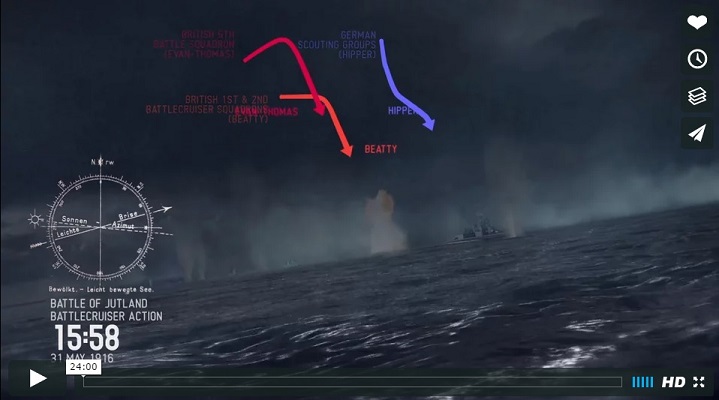
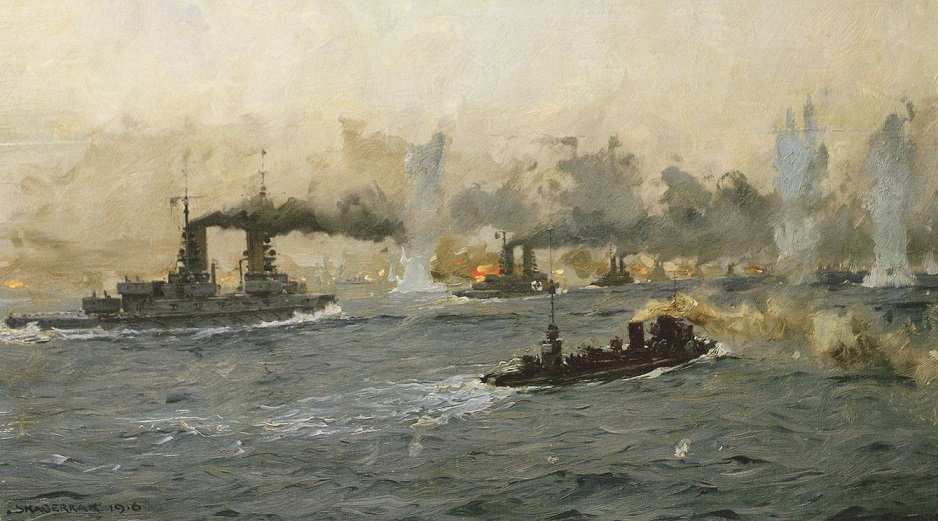
German battle line (foreground) fights it out with British battle line (backgound).
The
Story of Boy (2nd Class) Jack Cornwell, VC (posthumous)
16 years old, wounded, the only survivor of his gun crew.
He stayed at his post while he slowly bled to death.
"Lest We Forget"

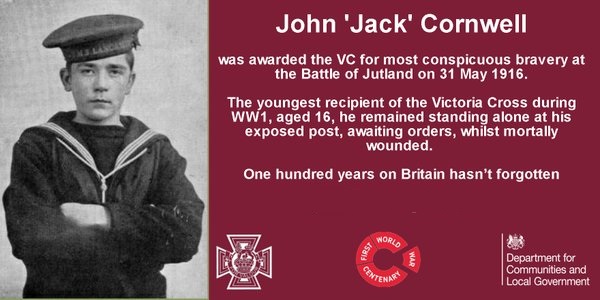
"This year marks 100 years since the Battle of Jutland,
and all I would ask is; do not forget Jack,
and those who fell alongside him." - Able Seaman Alexander Saridis,
RN, Jack's great-great nephew.
Lord
Kitchener Wants You 1914
recruiting poster, aka The Finger.
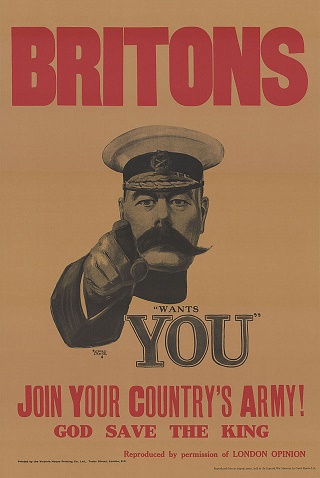
Britain did not have The Draft until 1916. They tried to shame men into
joining up.
The British Army did not get enough new men that way, especially after the
Battle of the Somme.
Therefore, The Draft.
Battle of Verdun February to December 1916. Fought in an area not quite 6 miles/19 Km on a side. About 1,000,000 men on each side. 700,000 dead or wounded (that's about 1 in 3). In the end, the French re-captured the whole area, including one town that was captured and then re-captured 16 times. The Germans ended up where they had been in February. A French victory, if you want to call it that.
Summer 1916 - Battle of the Somme 57,000 British dead & wounded - in ONE HOUR. Four and a half months later, the Germans had been pushed back a whole 10 Km (6 miles). "It took place between 1 July and 18 November 1916 on both sides of the upper reaches of the River Somme in France. It was the largest battle of the First World War on the Western Front. More than one million men were wounded or killed, making it one of the bloodiest battles in human history." - Wikipedia
April 2nd 1917 - British Commonwealth forces link up with the Russian Army northeast of Baghdad. This cuts off the Turkish forces in the area. The Turks retreat into Iran.
Just as the Russian Revolution forces the Russian Army to quit the war, America joins the Allies.
April 6, 1917 - USA declares war on Germany
“Black Death” – Henry Johnson – American’s First World War Hero
The 369th Infantry Regiment, the “Harlem Hellfighters”, was an all-black segregated outfit that went to France in WW I. The fanatically racist US Army deliberately and systematically abused and humiliated the men of the 369th because black. The French Army took them in and equipped them. They were given French rifles and helmets, and stationed in the trenches. One night, Johnson and Needham Roberts had guard duty. They were attacked at 2AM by German raiders. The two Americans chased away the German survivors after a spectacular fight. Both of them were badly hurt. Johnson was shot or stabbed 21 times!
"The whole French force in the region gathered to
see Johnson and Roberts awarded the Croix du Guerre, the county’s
highest military honor. They were the first U.S. soldiers ever to earn
this distinction. Johnson’s medal was further adorned with the
Gold Palm." Also the two were automatically made citizens of France.
Back in America, the 369th had their own victory parade. They were not
allowed to march with the white soldiers, because they were black. Almost
100 years later, President Obama awarded Johnson the well-deserved Medal
of Honor. The US Army never gave him any medals or veterans' benefits,
because black. You should read the whole article.
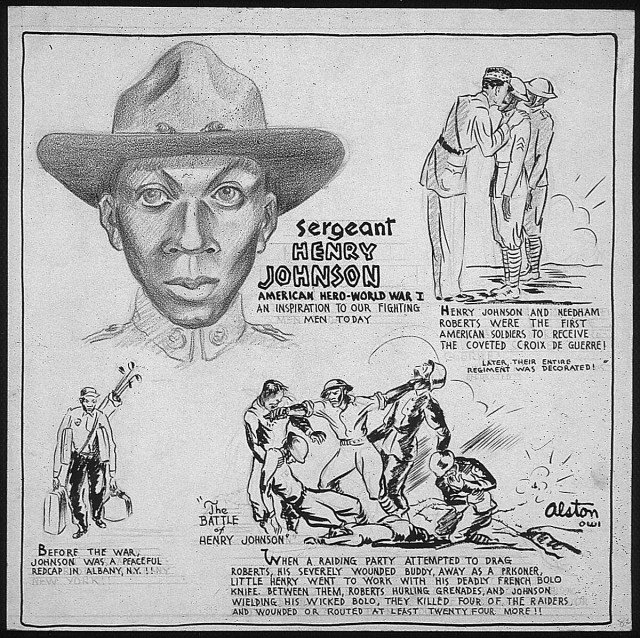
A 1946 biographical cartoon of Henry Johnson created by Charles Alston
April 9, 1917 - The Canadian Army begins the Battle of Vimy Ridge "The Canadians showed they were one of the outstanding formations on the Western Front and masters of offensive warfare."
![]() Canada
and World War I (starts about 1/3 of the way down the page). Well-presented
facts and links about this subject. "As we study World War I you should
remember the ordinary men and women who lived, worked, fought, and died,
and the important changes they helped to bring about." Includes a list
of the causes of the war with explanations; the major battles Canadians
were in, letters home, enlistment records, and a glossary. A small part
of Mr.
MacLeod's CWS Pages by a teacher who loves the subject.
Canada
and World War I (starts about 1/3 of the way down the page). Well-presented
facts and links about this subject. "As we study World War I you should
remember the ordinary men and women who lived, worked, fought, and died,
and the important changes they helped to bring about." Includes a list
of the causes of the war with explanations; the major battles Canadians
were in, letters home, enlistment records, and a glossary. A small part
of Mr.
MacLeod's CWS Pages by a teacher who loves the subject.
Causes of World War I, Causes of WW I, and WW I PowerPoint are three of many such works on SlideShare, where people share PowerPoints and slide shows about pretty much everything. These appear to be done by secondary school students. These are ways to quickly transfer information about WW I.
Over the Top is a RPG simulation from the Canadian War Museum about life in the trenches. "Carefully read the text and decide your fate! Use the arrows to advance the storyline." Students will make life or death choices. Undergo artillery barrages, endure a gas attack, do guard mount, pull night lookout duty, go on a trench raid, more. Gritty and realistic. And don't let your kid brother come with.
 Prelude
to Gallipoli - Naval Bombardment of the Dardanelles I THE GREAT WAR
Week 31. Kudos to reddit user Frankeh, who wrote: "This Youtube channel
is making a weekly ~10 minute documentary about what happened in WW1 this
week exactly 100 years ago. The idea being that there's a documentary for
every week of WW1 by 2018. Their videos only get ~10,000 views but they're
great!" Indeed they are.
Prelude
to Gallipoli - Naval Bombardment of the Dardanelles I THE GREAT WAR
Week 31. Kudos to reddit user Frankeh, who wrote: "This Youtube channel
is making a weekly ~10 minute documentary about what happened in WW1 this
week exactly 100 years ago. The idea being that there's a documentary for
every week of WW1 by 2018. Their videos only get ~10,000 views but they're
great!" Indeed they are.
Trench Warfare in the First World War from Spartacus Educational (HUGE history-ed site). Over 50 well-researched subtopics; under Life in the Trenches, The Trench System, and Trench Warefare. Anything you would want to know.
Trench Warfare in World War I Was a Smarter Strategy Than You Realize Trenches offered protection from artillery fire. Trench systems evolved over time. German trench systems went farther back than Allies' trenches, for "defense in depth". There are also videos and trench diagrams.
This Is How The Different Armies Approached Trench Warfare In The First World War by Andrew Knighton, as published in War History Online on FB. Godd analysis of this subjects. The British Empire, France, and Germany all had different views on depending on war plans and how they meant to fight the war. The Germans had the most organized and well built trenches, with up to three layers of trenches. They meant to dig in and wait until Russia gave up, and all the German divisions out East could come west to help them. British trenches were poorly made and not supposed to last long. British troops were supposed to be attacking all the time. French trenches were somewhere in between, depending on the battle ground situation. Lots of good photos.
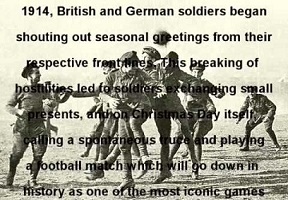
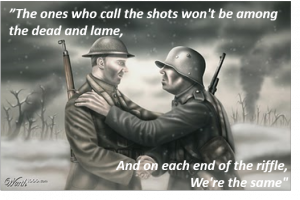
The Christmas Truce of 1914 "During World War I, on and around Christmas Day 1914, the sounds of rifles firing and shells exploding faded in a number of places along the Western Front in favor of holiday celebrations in the trenches and gestures of goodwill between enemies." There was an epic pickup football game (soccer). Germans won, 4-3.
From top right: War Dog, donkey, mule,
homing pigeon, camel, cavalry mount
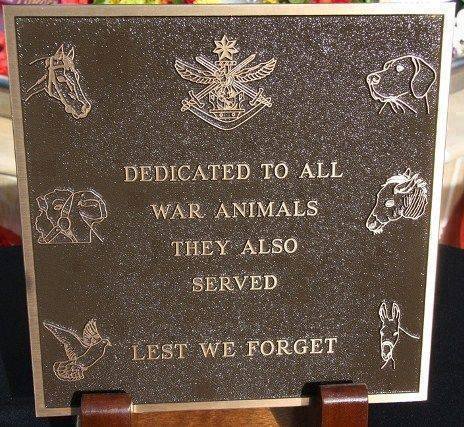
![]() to top of page
to top of page ![]()
![]() to Good Sites
to Good Sites![]()
![]() to History
to History